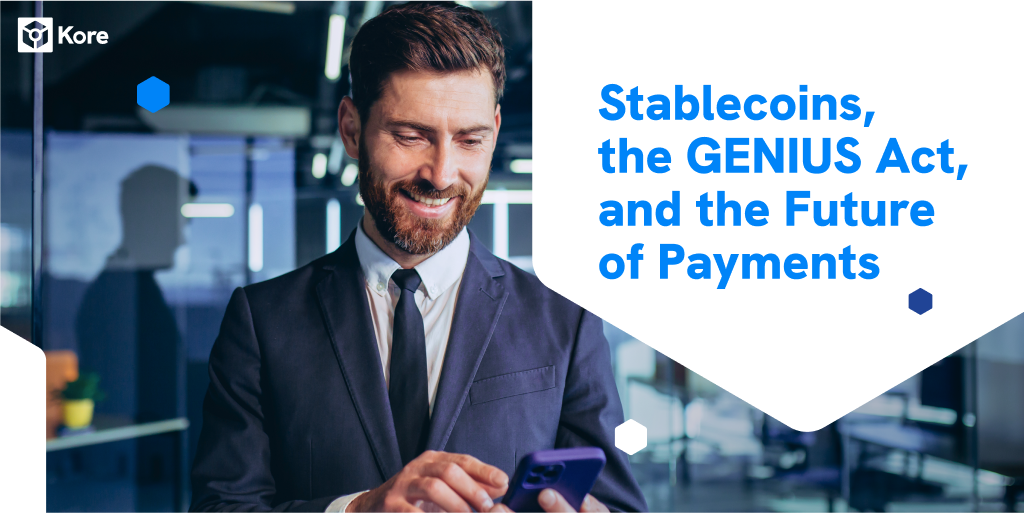Stablecoins, the GENIUS Act, and the Future of Payments

Stablecoins began as an interesting innovation in the crypto world to offer a “stable investment” or safe haven in volatile markets. But with regulatory pressure from the GENIUS Act, the survival of stablecoin issuers hinges on their becoming payment rails rather than speculative vehicles.
The GENIUS Act (Guiding and Establishing National Innovation for U.S. Stablecoins) is the first U.S. federal law to establish a comprehensive regulatory framework specifically for payment-stablecoins.
Key provisions of the GENIUS Act include:
- 100% reserve backing requirement: stablecoin issuers must hold fully collateralizing assets (U.S. dollars or low-risk assets such as short-term Treasuries) to back every stablecoin in circulation.
- Transparency and audit/disclosure rules: issuers must publish regular disclosures (e.g. monthly reserve composition) and undergo audit able verification.
- Licensing and supervision: stablecoin issuers must register with regulators and comply with anti-money laundering (AML), sanctions, and Know Your Customer (KYC) obligations under the Bank Secrecy Act.
- Marketing and consumer protections: the Act bans misleading claims (e.g., that a stablecoin is government-backed, federally insured, or legal tender) and seeks alignment between state and federal stablecoin rules.
- Priority of claims in insolvency: in the event of issuer failure, stablecoin holders are given priority claims over other creditors.
- Prohibition on interest payments by issuers: stablecoin issuers are barred from paying interest on the reserves themselves.
By enshrining these guardrails, the GENIUS Act attempts to bring legitimacy, risk mitigation, and consumer protection to the stablecoin ecosystem, positioning stablecoins more clearly as regulated payment instruments.

Why Stablecoins Could Be Powerful as Payment Mechanisms
- Fast Settlement
One of the most compelling advantages of stablecoins is their ability to settle payments nearly instantly, even across national borders. Traditional cross-border transfers often traverse multiple correspondent banks, clearing houses, and time zones, causing delays of hours to days. In contrast, stablecoins can move value peer-to-peer, directly on a blockchain (or settlement layer), cutting out many intermediaries and enabling same-minute finality. This rapid settlement is a particularly powerful value proposition for businesses managing supply chains, cash flow timing, or international payables. - Low Latency / 24/7 Availability
Unlike traditional banking systems, which operate on limited business hours and observe weekends, holidays, or regional banking hours, stablecoin rails can run continuously, 24 hours a day, seven days a week. That means funds can move at any hour, without waiting for clearing windows or banking cutoffs. Because the underlying network is always “on,” users and merchants can transact even outside the confines of traditional banking hours. This availability materially reduces friction—no more waiting overnight for funds to clear when you need to pay or get paid immediately. - Programmability & Composability
Payments can carry logic, triggers, or conditions. Stablecoins aren’t just “dumb money.” They can carry programmable logic, adding rich capability to payments. Smart contracts can embed conditions such as “transfer when delivery confirmed,” “pay on milestone completion,” or “refund automatically on failure.” That kind of programmable money allows transactions to self-execute without intermediaries. Moreover, because stablecoins are composable, they can interoperate with other smart contracts and decentralized components (e.g. DeFi primitives), melding payments, credit, escrow, and conditional flows into a seamless experience.
- Transparency and Verifiability
Another key strength is auditability: with blockchain-based stablecoins, every transaction is recorded in a public (or permissioned) ledger, creating a traceable, permanent on-chain record. That visibility enables real-time reconciliation, fraud detection, and compliance monitoring. A well-architected stablecoin system can allow regulators, auditors, or users to verify reserve backing, transaction flows, and issuer behavior without opaque off-ledger accounting. This transparency can build trust in the system and reduce counterparty risk.
- Financial Inclusion Potential
Finally, stablecoins carry promise for financial inclusion. Many individuals in underserved markets lack access to traditional banking, or face high remittance fees, limited hours, or insufficient infrastructure. With a smartphone and connectivity, they can access stablecoin-based payment rails—bypassing legacy gatekeepers. That can enable low-cost remittance flows, micropayments, and global participation in commerce. Stablecoins may serve as a “digital dollar rail” for markets where domestic financial systems are weak or fragmented. (Indeed, many stablecoin use cases today focus on cross-border remittances in emerging markets.)
These are precisely the use cases that lean into stablecoins’ differentiator vs. crypto assets.
The Fundamental Flaw: Blockchain Transaction Fees
Most stablecoins ride existing blockchains that impose transaction (gas) fees. That introduces three critical problems:
- Cost unpredictability: Gas prices fluctuate wildly, sometimes spiking, adding friction and risk to payments.
- No fiduciary accountability: Miners and validators are economically self-interested and do not bear legal duties, unlike regulated payment processors.
- Regulatory mismatch: Miners and validators are not (and typically cannot be) licensed money transmitters, further complicating legal compliance.
In other words, the architecture reintroduces cost inefficiency (via gas) while layering new uncertainty and decentralization risk. It’s not enough to remove credit card interchange or banking fees if you tack on volatile “blockchain fees” and governance risk.
If stablecoins are to succeed as real-world payment rail alternatives, we need architectures (or hybrid solutions) that eliminate transaction costs and embed accountability, compliance, and predictability in the system.


